
Ripe Chick's Skull
"Ripe chick's skull, longitudinal section, vied inside, x 3 diameters; after parker. In the mandible…
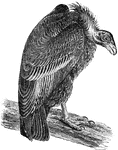
California Condor
"Pseudogryphus californianus. California Condor. Adult: Blackish, the feathers with browner tips or…

Coot Head
"Fulicia. Coot. Bill and frontal plate much as in the Gallinultes. Body depressed; the under plumage…

Cormorant
The Cormorant "P. carbo, but has a tuft of long narrow recurved plumes on each side f the crown in the…
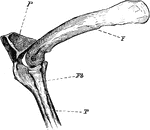
The Knee-joint of a Cormorant
"Phalacrocorax bicristatus. Cormorant. The knee-joint of a Cormorants. F, femur; P, patella; T, tibia;…

Double-crested Cormorant
"Phalacrocorax dilophus. Double-crested Cormorant. Tail of 12 feathers. Gular sac convex behind. No…
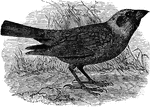
Common Cowbird
"Molothrus ater. Common Cowbird. Cuckold. male Adult: Lustrous green-black, with steel-blue, purple,…

Sandhill Crane Windpipe
"Coiling of the windpipe in the sternum of Grus canadensis. Sandhill Crane." Elliot Coues, 1884
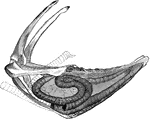
Whooping Crane Windpipe
"Very generally, in cranes and swans, the trachea enters the keel of the sternum, which is excavated…

Black and White Creeper
"Black and White Creeper or Mniotilta varia. Black; edges of feathers of upper parts, coronal, superciliary,…
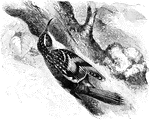
Common Brown Creeper
"Common Brown Creeper. Upper parts dark brown, changing to rusty-brown on the rump, everywhere streaked…
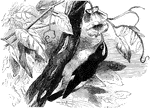
Honey Creeper
"Certhiola flaveola. Honey Creeper. Dark brown above; long superciliary line and under parts dull white;…
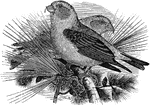
American Red Crossbill
"Loxai curvirostra. American Red Crossbill. Red; wings and tail blackish, without white markings. Middle…
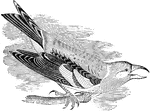
White-winged Crossbill
"Loxia leucoptera. White-winged Crossbill. Rosy-red, sometimes carmined or even crimsoned, obscured…

Blue Crow
"Gymnocitta cyanocephala. Blue Crow. Male: Dull blue, very variable in intensity, nearly uniform, but…

Small Yellow-billed Cuckoo
"Coccygus americanus. Yellow-billed Cuckoo. Bill black, extensively yellow below and on the sides of…
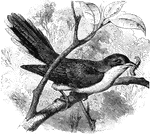
Yellow-billed Cuckoo
"Coccygus americanus. Yellow-billed Cuckoo. Bill black, extensively yellow below and on the sides of…
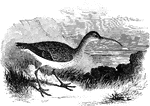
Hudsonian Curlew
"Numenius hudsonicus. Hudsonian Curlew Jack Curlew. General tone of coloration scarcely rufous, the…
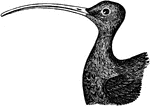
long-billed Curlew
"Numenius longirostris. Long-billed Curlew. Sickle-bill. Plumage very similar to that of the Godwit,…

American Dipper
"Adult, in summer: Slaty-plumbeous, paler below, inclining on the head to sooty-brown. Quills and tail-feathers…
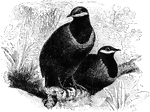
Blue-headed Quail Dove
"Starnaenas cyanocephala. Blue-headed Quail Dove. Crown rich blue bounded by black; a white stripe under…

Carolina Dove
"Zenaidura carolinensis. Carolina Dove. Mourning Dove. Wild Dove. Upper parts, including middle tail-feathers,…
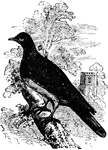
European Ring Dove
Columba palumbus. European Ring Dove. Wood Pigeon. Plumage is gray with a pinkish-purplish breast and…

Pin-tail Duck Head
"Dafila. Pin-tail Ducks. Tail (in adult male) narrow, cuneate, when fully developed nearly as long as…
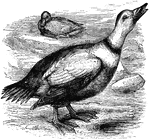
Labrador Duck
"Camptolaemus labradorius. Labrador Duck. Pied Duck. Adult male: Bill black with orange at base and…

Surf Duck
"Oidemia perspicillata. Surf Duck. Sea Coot. Adult male: Bill as above, singularly variegated in color,…

Trowbridge's Surf Duck
"Oidemia perspicillata trowbridgii. Trowbridge's Surf Duck, With the bill longer, exceeding the head,…
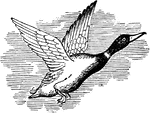
Wild Duck
"Anus boscas. Mallard. Wild or Domestic Duck. Green-head. Bill greenish-yellow. Feet orange-red. Iris…
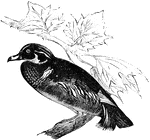
Wood Duck
"Aix sponsa. Wood Duck. Summer Duck. "The Bride." Adult Male: Bill pinkish-white, with lake-red base,…
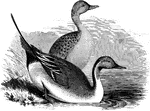
Pin-tail Ducks
"Dafila acuta. Pin-tail Duck. Sprig-tail. Bill black, with grayish-blue edge of upper mandible; feet…

Eagle Cochlea
"Cochlea, X3. a, external, b, internal, cartilaginous prism; c, membranous zone; d, saccular extremity…

A Section of an Eagle's Cochlea
"Section of the cochlea, X3. a, vestibular surface of external cartilaginous prism, extending into d,…

The Inner Ear of a White-tailed Eagle
"Membranous labyrinth of Haliaetus albicilla (White-tailed Eagle), X2. a,b, cochlea; b, its saccular…
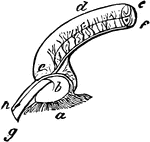
Eagle's Ampulal
"Part of the superior vertical semicircular canal, showing its ampulla (which is the dilatation of the…

The Inner Ear of an Eagle
"Membranous labyrinth of Haliaetus albicilla (White-tailed Eagle), X2. a,b, cochlea; b, its saccular…

Bald Eagle
"Haliaetus leucocephalus. White-headed Sea Eagle. "Bald Eagle." "Bird of Washington". Adult: Dark brown;…
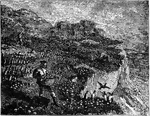
Murre's Eggs
A man is gathering Murre's eggs from their nesting cliff. Birds lay single eggs and eggs are elongated…

The Bill of an Eider
"Somateri mollissima. Somateri dresseri. Common Eider. Bill gibbous at base of upper mandible; outline…
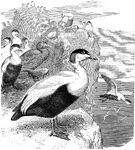
Eider Ducks
"Somateria mollissima. European Eider Duck. Bill with lateral frontal process extending on each side…
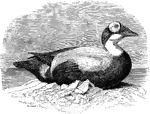
Spectacled Eider
"Somateria fischeri. Spectacled Eider. Bill (in both sexes) peculiar in the extension upon it of dense…
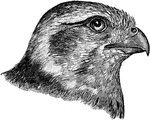
Prairie Falcon Head
"Falco mexicanus. American Lanner Falcon. Prairie Flacon. A medium-sized species, distinguished from…

Falcons
"Falcons. Bill furnished with a sharp tooth and notch near the end of the cutting edge of the upper…
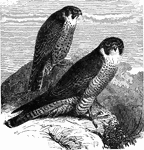
Two Lanner Falcon
"Falco mexicanus. American Lanner Falcon. Prairie Flacon. A medium-sized species, distinguished from…
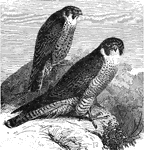
Two Peregrine Falcons
"Falco peregrinus. Peregrine Falcon. Duck Hawk. Great-footed Hawk. A medium-sized falcon, about as large…

Peregrine Falcon Small
"Falco peregrinus. Peregrine Falcon. Duck Hawk. Great-footed Hawk. A medium-sized falcon, about as large…

The Bill of a Purple Finch
"Carpodacus. Purple Bullfinch. Bill smaller and less turgid than in Pinicol or Pyrrhula, more regularly…
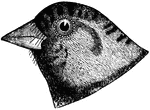
Brandt's Rosy Finch
"Leucosticte griseinucha. Brandt's Rosy Finch. Like the littoral variety of tephrocotis, in having the…
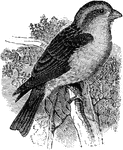
Purple Finch
"Carpodacus purpureus. Purple Finch (better Crimson Finch). Rose-red, paler below, insensibly whitening…
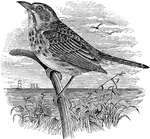
Seaside Finch
"Ammodramus maritimus. Seaside Finch. Olive-gray, obscurely streaked on back and crown with darker and…

Swainson's Rosy Finch
"Leucosticte tephrocotis. Swainson's Rosy Finch. Gray-crowned Rosy Finch. Sexes similar. Adult in breeding…
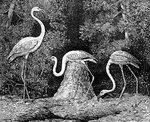
American Flamingo
"Phoinikopteros ruber. American Red Flamingo. Adult: Plumage scarlet, the primaries and most of the…
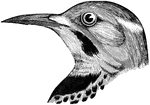
Flicker
"Colaptes auratus. Golden-winged Woodpecker. Pigeon Woodpecker. Flicker. Yucker. High-holder. Back and…
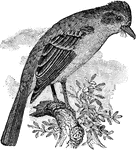
Ash-throated Flycatcher
"Myiarchus cinerescens. Ash-throated Crested Flycatcher. Rather olivaceous-brown above, quite brown…

Derby Flycatcher
"Pitangus derbianus. Derby Flycatcher. Under parts light wood-brown, with an olive tinge; wings and…
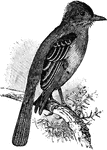
Great Crested Flycatcher
"Myiarchus crinitus. Great Crested Flycatcher. Decidedly olivaceous above, a little browner on head,…
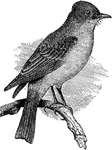
Pewit Flycatcher
"Sayiornis fusca. Pewit Flycatcher. Water Pewee. Pewit. Phaebe. Dull olivaceous-brown, the head much…

Swallow-tailed Flycatcher
"Milvulus forficatus. Swallow-tailed Flycatcher. Scissor-tail. Crown patch orange or scarlet. General…
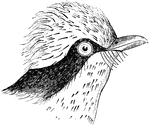
Vermilion Flycatcher
"Pyrocephalus rubineus mexicanus. Vermilion Flycatcher, Adult male: Pure dark brown, including stripe…

Meadow Lark Foot and Bill
"Sturnella magna. Field Lark. Old-field Lark. Meadow Lark. The colors, as above described, rich and…

Grackle Foot
"Quiscalus. Grackle. The feet are large and strong, and the birds spend much of their time on the ground,…